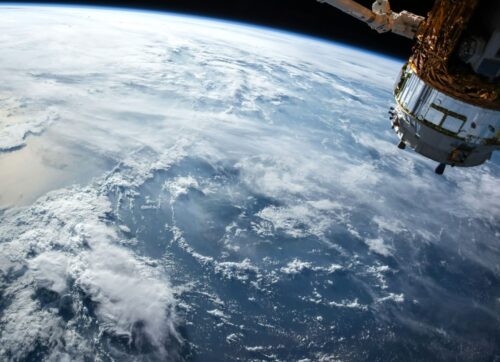
The National Oceanic and Atmospheric Administration (NOAA) predicts July, August, and September will be hotter than usual. And for those who view warmer temperatures as problematic, that’s a significant cause for concern. [emphasis, links added]
“Earth’s issuing a distress call,” said United Nations Secretary-General António Guterres on March 19. “The latest State of the Global Climate report shows a planet on the brink.
“Fossil fuel pollution is sending climate chaos off the charts. Sirens are blaring across all major indicators: Last year saw record heat, record sea levels, and record ocean surface temperatures. … Some records aren’t just chart-topping, they’re chart-busting.”
President Joe Biden called the climate “an existential threat” in his 2023 State of the Union address. “Let’s face reality. The climate crisis doesn’t care if you’re in a red or a blue state.”
In his 2024 address, he said, “I don’t think any of you think there’s no longer a climate crisis. At least, I hope you don’t.”
When recalling past temperatures to make comparisons to the present, and, more importantly, inform future climate policy, officials such as Mr. Guterres and President Biden rely in part on temperature readings from the United States Historical Climatology Network (USHCN).
The network was established to provide an “accurate, unbiased, up-to-date historical climate record for the United States,” NOAA states, and it has recorded more than 100 years of daily maximum and minimum temperatures from stations across the United States.
The problem, say experts, is that an increasing number of USHCN stations don’t exist anymore.
“They are physically gone—but still report data—like magic,” said Lt. Col. John Shewchuk, a certified consulting meteorologist.
“NOAA fabricates temperature data for more than 30 percent of the 1,218 USHCN reporting stations that no longer exist.”
He calls them “ghost” stations.
Mr. Shewchuck said USHCN stations reached a maximum of 1,218 stations in 1957, but after 1990 the number of active stations began declining due to aging equipment and personnel retirements.
NOAA still records data from these ghost stations by taking the temperature readings from surrounding stations, and recording their average for the ghost station, followed by an “E,” for estimate.
The addition of the ghost station data means NOAA’s “monthly and yearly reports are not representative of reality,” said Anthony Watts, a meteorologist and senior fellow for environment and climate at the Heartland Institute.
“If this kind of process were used in a court of law, then the evidence would be thrown out as being polluted.”
Critical Data
NOAA’s complete record of USHCN data is available on its website, making it a vital tool for scientists examining temperature trends since before the Industrial Revolution.
Jamal Munshi, emeritus professor at California’s Sonoma State University, wrote in a 2017 paper that because many of the stations in the USHCN, and their data, date back to the 1800s, they’ve been “widely used in the study of global warming.”

“The fear of anthropogenic global warming has generated a great interest in temperature trends such that even minute changes in the temperature record are scrutinized, and controversial implications for their effects on climate, extreme weather, and sea level rise are weighed against the cost of reducing emissions as a way of moderating these changes,” Mr. Munshi wrote.
“Energy and development policy around the world are impacted by these evaluations.”
Mr. Shewchuk said the USHCN data is the only long-term historical temperature data the United States has.
“In these days of apparent ‘climate crisis,’ you would think that maintaining actual temperature reporting stations would be a top priority—but they instead manufacture data for hundreds of non-existent stations. This is a bizarre way of monitoring a climate claimed to be an existential threat,” he said.
“Observed data is real. Altered and fabricated data is not real. Period.”
The website, noaacrappy, lists all of the ghost, or “zombie” stations, their location, how long they’ve been closed, and then links to NOAA’s recordings.
Significantly, the map shows, not all of the stations used to interpolate temperature data are near the closed station.
Thus, hypothetically, it’s possible that since Oklahoma City’s stations are all “zombies,” interpolation data is coming from as far away as Gainesville, Texas, which is more than 136 miles away, and Enid, Oklahoma, which is more than 100 miles away.
Read rest at Epoch Times



















The whole rotten United Nations needs to get the Boot and moved to Moscow or Beijing without American Taxpayers having to foot the bill and pay the rest for these uninvited Guests just like with those filthy squatters being allowed to take over your home and evict you
AGW is not fraud
It is real, and harmless
CAGW is science fraud
NOAA and NASA-GISS have repeatedly made arbitrary adjustments and used improperly sited land weather stations. There is also infilling, maybe slightly higher than I thought (25% of all surface grids have at least some infilled guesses numbers)
We have UAH satellite data as a check and balance
The planet is about +1 degree warmer than in 1975. partially from a recent El Nino
So what?
The predictions of CAGW are NOT based on any historical climate trend. CAGW is a new fatasy climate. The predictions only required some global warming since 1975. But UAH data would be just as good as NASA-GISS, HadCRUT or NOAA
For the US, the NOAA USCRN network reflects warming of +0.34 degrees C. per decade since 2005 versus UAH at +0.14 degrees C. per decade since 1979. The NOAA Clim Div network is almost the same as NOAA’s USCRN.
NOAA’s USCHN is not used anymore
The news about NOAA and NAS-GISS for several decades tells us they are not honest science organizations
But their predictions of CAGW are not based on science
They are data free CAGW predictions that hav ebee wrong since 1979. With no relationship to any historical climate. CAGW is an imaginary climate.
https://honestclimatescience.blogspot.com/
Sloth and fraud. Has any effort been made to replace the missing stations? No. Easily done, affordable. So why not? They don’t want temperature data from rural locations to dilute AGW supportive “hotter” data from urban locations. I remember that the warmists pulled this trick when compiling historical data. Africa had almost no data to add, so they made some up. Everything they claim is in the same vein to support the AGW fraud.